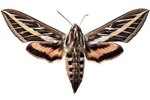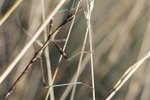
Wherever there are butterflies or moths, you'll find caterpillars, which are the larval form of the Lepidoptera order of insects. The rain forest's blue morpho caterpillar doesn't receive the admiration as the Blue morpho butterfly does, for example, as it's widely regarded a pest. Thousands of caterpillar species inhabit the world's rain forests, only a fraction of which are known to scientists.
Caterpillars and the Rain Forest
Although caterpillars are commonplace, relatively little is known about them. Naturalists predict that the number of known species could eventually run into the millions as new species are being catalogued all the time. Caterpillar expert Dr. Lee Dyer of Tulane University estimates 5,000 caterpillar species live in the Costa Rican rain forest and says the caterpillar occupies a complex niche in the rain forest ecosystem, influencing plant life and the populations of predators and parasites.
Diner and Dinner
One of the reasons the caterpillar is regarded as a pest is because the creature munches his way through more leaves than any other herbivore. The butterfly, apart from looking pretty, has a very different diet and delicately sips nectar from flowers without destroying them. Some of the larger rain forest caterpillars can eat their way through an entire banana tree leaf in a day, presenting problem for plantation owners. Predators and parasitoids keep the caterpillar population in check. The caterpillar's natural predators are birds, small mammals and reptiles. Wasps, flies and nematode worms are parasitoids who lay their eggs in, or on, caterpillars. This kills the larvae. Parasitoids emerge from the pupal stage. Rain forests have high levels of parasitoids, according to the research of Dr. Dyer, which helps keep the caterpillar population in balance with the rest of the ecosystem.
Caterpillar Defenses
Caterpillars have a range of defenses. Coloration and small size allow him to blend into a leafy background and make him hard to find. In terms of behavior, some caterpillars find safety in numbers and congregate in groups to feed. More solitary types roll a leaf around them or cover themselves in a silky web. Some of the rain forest caterpillars repulse predators by thrashing about and vomiting, while some of the larger species attack and bite enemies. Bristles and spines prevent some predators from biting them or parasites from laying eggs. Some caterpillars even have fake limbs that detach when a predator grabs hold, according to Dr. Dyer's research. Rain forest caterpillars have another useful adaptation: A number of rain forest plant leaves contain toxins that prevent many animals from eating them. Some caterpillars, with developed immunity to these poisons, absorb them into their own tissues, thus making themselves inedible.
Caterpillars and Climate Change
Dr. Dyer's research in the rain forests of Costa Rica and Ecuador reveals a correlation between climate change and caterpillar populations. The studies show that climate affects the ability of parasitoids to find caterpillar hosts. Dyer looked at regions ranging from tropical rain forest to dry regions and discovered that the number of parasitoids decreased in dry conditions, leading to larger caterpillar populations. However, any extreme weather events could cause radical changes in rain forest insect populations, according to Dyer, who suggests an explosion in the rain forest caterpillar population could destabilize the ecosystem's balance.
References
Resources
Photo Credits
-
Jupiterimages/Photos.com/Getty Images
Writer Bio
Based in London, Eleanor McKenzie has been writing lifestyle-related books and articles since 1998. Her articles have appeared in the "Palm Beach Times" and she is the author of numerous books published by Hamlyn U.K., including "Healing Reiki" and "Pilates System." She holds a Master of Arts in informational studies from London University.




